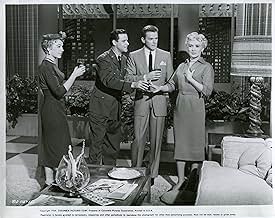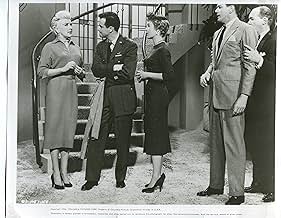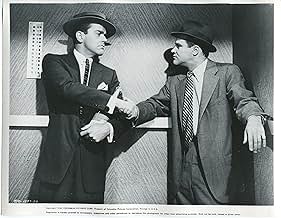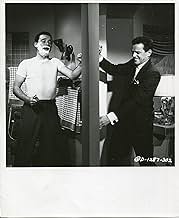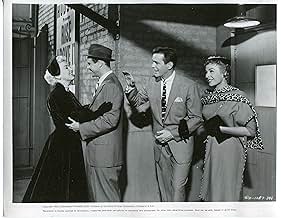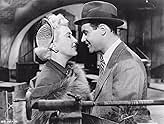IMDb RATING
6.1/10
512
YOUR RATING
A widowed singer marries her deceased husband's songwriting partner which leads to trouble when her former husband turns up very much alive.A widowed singer marries her deceased husband's songwriting partner which leads to trouble when her former husband turns up very much alive.A widowed singer marries her deceased husband's songwriting partner which leads to trouble when her former husband turns up very much alive.
- Director
- Writers
- Stars
David Ahdar
- Male Harem Dancer
- (uncredited)
Leon Alton
- Stage Manager
- (uncredited)
Tom Anthony
- Bit Role
- (uncredited)
Robert Bice
- Sgt. Charlie O'Hallihan
- (uncredited)
Bill Boes
- Male Harem Dancer
- (uncredited)
Eugene Borden
- Costume Designer
- (uncredited)
Johnny Brazil
- Male Harem Dancer
- (uncredited)
Eddie Brown
- Male Harem Dancer
- (uncredited)
George Bruggeman
- Male Harem Dancer
- (uncredited)
Aileen Carlyle
- Mother
- (uncredited)
Beulah Christian
- Wardrobe Woman
- (uncredited)
Gene Dailey
- Male Harem Dancer
- (uncredited)
John David
- Male Harem Dancer
- (uncredited)
- Director
- Writers
- All cast & crew
- Production, box office & more at IMDbPro
Featured reviews
Musical version of 1940's "Too Many Husbands", via W. Somerset Maugham's play "Home and Beauty" (which the author said he wrote as a lark), has widowed--and remarried--Broadway star in a marital quandary: her first husband's death overseas was misreported by the US Air Force (he was actually marooned on an island), and now she has two husbands...and both marriages legal! Betty Grable toys with the possibilities--she even fantasizes a musical number with dozens of suitors housed in cages, climaxing with she and her two husbands under the sheets smoking a hookah! But, this being 1955, we instead have Betty ordering both her husbands out of her boudoir come bedtime. The plot predicament, not surprisingly, doesn't come to much, but in the interim we have some bright moments, not the least of which is Grable's Marilyn Monroe-like delivery in the final number, "How Come You Do Me Like You Do" (which sounds a lot like MM's "Lazy" with a design resembling her "Heat Wave"). Director H. C. Potter opens the picture with a berserk pantomime number danced to "Someone To Watch Over Me" (in harlequin costumes!), but he gets good performances from both Grable and Jack Lemmon (who also sings a little and dances a bit). As the second couple, Marge and Gower Champion dance nicely together but don't have much pizzazz, much like the rest of "Three For the Show". A pleasant marquee-filler but hardly a headliner. **1/2 from ****
If you have managed to somehow miss this musical, watching it 60+ years after it was released is a revelation. Betty Grable's appeal makes sense to me at last, in this her last major film at the age of 39. The plot in a nutshell: A successful performer has been widowed by World War II. She marries her late husband's songwriting partner, played by Gower Champion, but the new marriage becomes a racy ménage a trois when her first husband, played by Jack Lemmon, shows up alive and eager to claim his conjugal rights. Grable plays her cards right, through a series of dreamy song and dance sequences with music by George and Ira Gershwin, Cole Porter, and Hoagy Carmichael. The extraordinary dance team of Marge and Gower Champion has never looked better, nor have "Someone to Watch Over Me," "Just One of Those Things," and "I've Got a Crush on You" ever sounded better. Some critics say Grable imitated Marilyn Monroe; I prefer to think that her performance was a gesture of handing over the "Hollywood's hottest blonde" crown to Monroe and quitting while she was ahead, which she definitely was in this film. Favorite line from Grable: I've got what most women want-a lover and a husband and they're both legal!"
What an interesting pedigree Three For The Show had, dating all the way back to 1920 when W. Somerset Maugham's play Too Many Husbands debuted on Broadway with a long forgotten cast. It had a military background instead of a show business one, though the military does figure prominently in the plot.
Collaborators Jack Lemmon and Gower Champion have a hit show on Broadway for producer Myron McCormick that stars Betty Grable. Lemmon goes into the Air Force during the Korean War and goes MIA. He's reported killed and Grable who was married to Lemmon, now marries Champion. Then of course Lemmon returns and they've a situation the reverse of My Favorite Wife.
In the meantime poor Marge Champion is champing at the bit because she's got a thing for Gower. I think you can figure out where this one is going.
The numbers come from a variety of sources, some original, some Broadway, some classical. Betty Grable in what proved to be her next to last film did more serious type dancing here than in any other. But next to the Champions, she really did not look that good. It was unfair to cast her with them.
Grable also did not like working for Harry Cohn, she was used to another imperious studio mogul over at 20th Century Fox who had kind of eased her out of her number one spot for the fast rising Marilyn Monroe. But she thought he was a pussycat next to Cohn. Two For The Show was Betty's first outside film after 14 year at Fox.
Jack Lemmon proved to have a couple of good singing notes as he does accompany the rest on a number or two. He liked working with Grable because he felt she was unpretentious with a good sense of humor as apparently a lot of her colleagues did.
As a film though, Three For The Show will never rank first rate in the work of either Lemmon or Grable.
Collaborators Jack Lemmon and Gower Champion have a hit show on Broadway for producer Myron McCormick that stars Betty Grable. Lemmon goes into the Air Force during the Korean War and goes MIA. He's reported killed and Grable who was married to Lemmon, now marries Champion. Then of course Lemmon returns and they've a situation the reverse of My Favorite Wife.
In the meantime poor Marge Champion is champing at the bit because she's got a thing for Gower. I think you can figure out where this one is going.
The numbers come from a variety of sources, some original, some Broadway, some classical. Betty Grable in what proved to be her next to last film did more serious type dancing here than in any other. But next to the Champions, she really did not look that good. It was unfair to cast her with them.
Grable also did not like working for Harry Cohn, she was used to another imperious studio mogul over at 20th Century Fox who had kind of eased her out of her number one spot for the fast rising Marilyn Monroe. But she thought he was a pussycat next to Cohn. Two For The Show was Betty's first outside film after 14 year at Fox.
Jack Lemmon proved to have a couple of good singing notes as he does accompany the rest on a number or two. He liked working with Grable because he felt she was unpretentious with a good sense of humor as apparently a lot of her colleagues did.
As a film though, Three For The Show will never rank first rate in the work of either Lemmon or Grable.
This is a remake of TOO MANY HUSBANDS, which had starred Jean Arthur, Fred MacMurray, and Melvyn Douglas. Here, we get a tepid musical with Betty Grable and Jack Lemmon and Gower Champion as the male leads. The plot has been dismissed in favor of some musical numbers oddly built around decades-old Gershwin songs. Marge Champion and Myron McCormick co-star.
Lemmon has been proclaimed dead in the war (which war?) so Grable marries Champion. Lemmon returns, and the guys battle over the hefty star while Marge look on is distress. In the original film, the ending is ambiguous with both guys still in Arthur's life. Here, she pairs off with Lemmon. Bleh.
Gower Champion might have been a good dancer and director but he's a zero as a romantic lead. So is Lemmon. Marge Champion (a terrific beard) looks like Bea Benaderet in corsets. The MGM darlings (the Champions) were a total bust in films. Grable was long past her prime and even though she's only 39 here, looks OLD and FAT.
Lemmon has been proclaimed dead in the war (which war?) so Grable marries Champion. Lemmon returns, and the guys battle over the hefty star while Marge look on is distress. In the original film, the ending is ambiguous with both guys still in Arthur's life. Here, she pairs off with Lemmon. Bleh.
Gower Champion might have been a good dancer and director but he's a zero as a romantic lead. So is Lemmon. Marge Champion (a terrific beard) looks like Bea Benaderet in corsets. The MGM darlings (the Champions) were a total bust in films. Grable was long past her prime and even though she's only 39 here, looks OLD and FAT.
Betty Grable was 39 when she made this film, her last to be released, and her constant references to herself as a girl seem peculiar. Even more disturbing is the way she imitates the singing style of Marilyn Monroe in her numbers. She had just made "How To Marry a Millionaire" with Monroe and had commented that she felt she was handing her crown on to Monroe. But to see the great star Grable trying to be Monroe is a little sad.
The film itself is a mess of a thing - some good dance numbers featuring Marge and Gower Champion (Marge's fantasy sequence is very fine) and some good songs ("I've Got a Crush On You", "Someone to Watch Over Me")sit uncomfortably with the plot and the director never seems sure which style he is aiming for. It looks like an attempt to cover the breezy free style of the Gene Kelly/Stanley Donen musicals, with characters bursting into song all over the place and elaborate dance dream sequences. But the result is a confusion of styles and a plodding pace.
The plot concerns married Grable discovering her presumed dead first husband is still alive. She must then choose between new husband Gower Champion and old husband Jack Lemmon (who also happen to be a show writing team). This potentially serious situation, that probably occurred a lot after the war, is treated completely flippantly - and with Gower's real life wife hanging around it's not hard to guess how things will turn out. Lemmon is good, but looks uncomfortable singing and dancing. See this for the numbers - but make sure you see it in Cinemascope.
The film itself is a mess of a thing - some good dance numbers featuring Marge and Gower Champion (Marge's fantasy sequence is very fine) and some good songs ("I've Got a Crush On You", "Someone to Watch Over Me")sit uncomfortably with the plot and the director never seems sure which style he is aiming for. It looks like an attempt to cover the breezy free style of the Gene Kelly/Stanley Donen musicals, with characters bursting into song all over the place and elaborate dance dream sequences. But the result is a confusion of styles and a plodding pace.
The plot concerns married Grable discovering her presumed dead first husband is still alive. She must then choose between new husband Gower Champion and old husband Jack Lemmon (who also happen to be a show writing team). This potentially serious situation, that probably occurred a lot after the war, is treated completely flippantly - and with Gower's real life wife hanging around it's not hard to guess how things will turn out. Lemmon is good, but looks uncomfortable singing and dancing. See this for the numbers - but make sure you see it in Cinemascope.
Did you know
- TriviaMercury Records issued a 10-inch LP of the soundtrack, which would be the only contemporary soundtrack album released from a Betty Grable film.
- GoofsMartin 'Marty' Stewart appears in a U. S. Air Force uniform, yet several times in the movie various characters refer to him being in the U. S. Army.
- Quotes
Gwen Howard: I wonder what kind of champagne I should order.
Vernon Lowndes: Depends what you're launching.
- ConnectionsFeatured in L'univers du rire (1982)
- SoundtracksHow Come you Do Me Like You Do
Words and Music by Gene Austin and Ray Bergere
Performed by Betty Grable (uncredited)
- How long is Three for the Show?Powered by Alexa
Details
- Release date
- Country of origin
- Language
- Also known as
- Three for the Show
- Production company
- See more company credits at IMDbPro
- Runtime
- 1h 33m(93 min)
- Aspect ratio
- 2:55 : 1
Contribute to this page
Suggest an edit or add missing content

